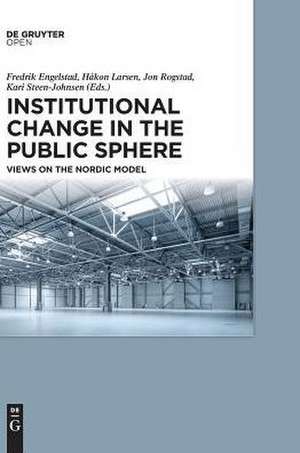Institutional Change in the Public Sphere
Editat de Fredrik Engelstad, Kari Steen-Johnsen, Jon Rogstad, Håkon Larsenen Limba Engleză Hardback – 24 apr 2017
There are further reasons to pay particular attention to the Scandinavian, and more specifically the Norwegian cases: (i) They are to varying degrees neo-corporatist societies, characterized by ongoing bargaining over social and political reform processes. From a theoretical perspective this invites reflections which, to some extent, are at odds with the dominant conceptions of institutional change. Neither models of path dependency nor models of aggregate, incremental change focus on the continuous social bargaining over institutional change. (ii) Despite recent processes of liberalization, common to the Western world as a whole, corporatism implies a close connection between state, public sphere, cultural life, and religion. This also means that institutions are closely bundled, in an even stronger way than assumed for example in the Varieties of Capitalism literature. Furthermore, we only have scarce insight in the way the different spheres of corporatism are connected and interact.
In the proposed edited volume we have collected historical-institutional case studies from a broad set of social fields (a detailed outline of contents and contributors is attached):
- Critical assessments of Jrgen Habermas' theory of the public sphere
- Can the public sphere be considered an institution?
- The central position of the public sphere in social and political change in Norway
- Digital transformations and effects of the growing PR industry on the public sphere
- Institutionalization of social media in local politics and voluntary organizations
- Legitimation work in the public sphere
- freedom of expression and warning in the workplace
- "Return of religion" to the public sphere, and its effects
Preț: 702.18 lei
Preț vechi: 911.91 lei
-23% Nou
Puncte Express: 1053
Preț estimativ în valută:
134.40€ • 146.04$ • 112.97£
134.40€ • 146.04$ • 112.97£
Carte tipărită la comandă
Livrare economică 21 aprilie-05 mai
Preluare comenzi: 021 569.72.76
Specificații
ISBN-13: 9783110546323
ISBN-10: 3110546329
Pagini: 282
Dimensiuni: 175 x 246 x 23 mm
Greutate: 0.72 kg
Editura: DE GRUYTER OPEN POLAND
ISBN-10: 3110546329
Pagini: 282
Dimensiuni: 175 x 246 x 23 mm
Greutate: 0.72 kg
Editura: DE GRUYTER OPEN POLAND
Notă biografică
Fredrik Engelstad, Håkon Larsen, Jon Rogstad, Kari Steen-Johnsen (Eds.)
